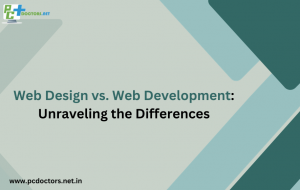Web Design vs. Web Development: Unraveling the Differences
- September 29, 2023
- web design, Web Development
- Posted by Administrator
- Leave your thoughts
In the digital age, where online presence is paramount, the terms “web design” and “web development” are often used interchangeably. However, they refer to distinct aspects of building a website, each playing a crucial role in creating a successful online platform. In this blog, we’ll unravel the differences between web design and web development, shedding light on their unique functions and the collaborative synergy required to create exceptional websites.
Web Design: The Artistic Architect
What is Web Design?
Web design is the creative and artistic facet of website development. It focuses on the visual elements and user experience (UX) of a website. A web designer’s primary goal is to create an aesthetically pleasing and user-friendly interface.
Key Responsibilities:
1. Layout and Aesthetics: Web designers decide how a website will look. They choose color schemes, typography, images, and overall layout to create an appealing visual experience.
2. User Experience (UX) Design: Ensuring that the website is easy to navigate and user-friendly is a crucial aspect of web design. This involves creating intuitive menus, buttons, and interactive elements.
3. Responsive Design: With the increasing use of mobile devices, web designers must ensure that websites adapt seamlessly to various screen sizes and devices.
4. Branding: Incorporating the client’s branding elements such as logos and corporate identity into the website design.
5. Wireframing and Prototyping: Creating wireframes and prototypes to visualize the website’s structure and functionality before actual development.
Tools of the Trade:
Web designers often use tools like Adobe XD, Sketch, Figma, and Photoshop to craft visually appealing website designs.
Web Development: The Master Builder
What is Web Development?
Web development, on the other hand, focuses on the technical aspects of bringing a website to life. Developers are responsible for turning the design into a functional website, coding the structure, and ensuring everything works smoothly.
Key Responsibilities:
1. Front-End Development: Front-end developers work on the visible part of the website that users interact with. They use HTML, CSS, and JavaScript to implement the design and create a responsive, interactive experience.
2. Back-End Development: Back-end developers build the behind-the-scenes infrastructure of a website. They work with databases, server-side scripting, and APIs to ensure data handling and security.
3. Functionality and Interactivity: Developers bring web applications and features to life. This includes e-commerce carts, login systems, content management systems (CMS), and more.
4. Performance Optimization: Optimizing the website for speed and efficiency is essential for a smooth user experience. Developers are responsible for code optimization and server performance.
5. Testing and Debugging: Developers rigorously test and debug the website to ensure it functions correctly across different browsers and devices.
Tools of the Trade:
Web developers utilize programming languages such as HTML, CSS, JavaScript, PHP, Python, and tools like Visual Studio Code, Sublime Text, and various content management systems (e.g., WordPress).
The Synergy Between Design and Development
Web design and web development are not isolated processes; they go hand in hand. Effective collaboration between designers and developers is essential for creating a seamless, visually appealing, and functional website. Here’s how they work together:
1. Design to Development Handoff: Designers provide developers with design files, prototypes, and specifications that serve as a blueprint for the development process.
2. Responsive Implementation: Developers ensure that the design is responsive and adapts to various devices, screen sizes, and resolutions.
3. User Experience (UX): Developers work closely with designers to implement the intended user experience, ensuring that interactive elements function smoothly.
4. Iterative Process: Design and development often involve iterations and feedback loops to refine the final product.
Conclusion
In the world of web development, both web design and web development play indispensable roles, with each contributing unique skills and expertise. While web designers craft the visual identity and user experience, web developers bring those designs to life with functionality and interactivity. However, it’s the synergy between these two disciplines that truly elevates a website to greatness. The harmonious collaboration of design and development results in seamless, visually captivating, and functionally superb online platforms that resonate with users.
If you’re looking for a partner to help you navigate this intricate web of web design and development, look no further than PC Doctors .NET. As a leading web design company in Bhubaneswar, PC Doctors .NET specializes in crafting visually stunning, user-friendly websites that stand out in the digital landscape. With Our expertise, your online presence can reach new heights and leave a lasting impression on your audience. our team combines the creative expertise of web design with the technical prowess of web development to deliver websites that not only meet but exceed your expectations. Whether you’re launching a new website or revamping an existing one, trust PC Doctors .NET to bring your online vision to life. Discover the power of exceptional web design and development with us today. For more details about Web Design Services, please visit https://pcdoctors.net.in/, or call 1800-889-0674 (TOLL-FREE).

